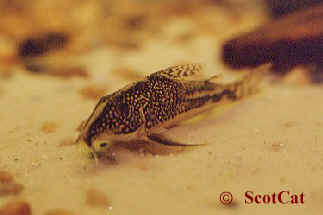After a few weeks they were
put into a 40"x 12"x 12 inch (1000mm x
300mm x 300 mm) Corydoras community tank where they
grew well during the summer months. They were fed
on a mixed diet of flake, beefheart/spinach mix,
white worms, and tubifex worms. My judgement had
been good - one female 3" (75mm) and two males
2" - 2½" (50mm - 62mm).
September:
On the Friday afternoon of our Bank holiday weekend
the barbatus decided to spawn, the female
was laying eggs 1" (25mm) below the water level,
all the eggs were placed in a tight clutch which
is unusual with Corydoras. It was not possible
to move the fish therefore the eggs were moved to
a 4"x 4"x 2"(100mm x 100mm x 50mm)
box and light aeration was used, somewhat later
than intended the family set off for Blackpool for
the weekend. Returning home on Monday night my first
concern was for the eggs, but alas all had perished,
so there was nothing for it but to try again. This
time the trio were placed in a 24" x 12"
x 12" (60cm x 30cm x 30cm) tank with ½"
of gravel which was planted with Cryptocorynes in
pots and subdued lighting, (water conditions were
P.H. 7 - Temperature 70o - 72o F - Dh ?). A week
passed , then a month, Christmas came and went,
and by this time the trio did not look happy at
all, so they were returned to the 40"Corydoras
community tank.
January:
One evening the female was very active swimming
up and down the front of the glass and showing great
interest in one of the males and butting him on
the side, after a time the male began to chase the
female around the tank, eventually they settled
on the gravel in the characteristic 'T' position.
The male gripped the females barbels with one of
its pectoral fins, after 5 - 10 seconds they broke
away and she swam to the top where she placed 10
- 15 eggs, she rested for a few minutes and then
went looking for the male. Sometimes she rested
on one side clasping the eggs in her pelvics and
seemed to be fanning the eggs with her pectoral
fins, 70 eggs were laid 2" (50mm) from the
water surface in a small clump as previously described.,
the spawning only lasted for a ½ hour, (P.H.
7 - Temperature 70o - 72o - Dh ?). I decided to
remove the eggs as the 40" tank was unsuitable
for rearing fry. The eggs were creamy coloured and
about 2mm in size, a 10" x 6" x 4"
(25cm x 15cm x 10cm) tank containing 3" (75mm)
of water taken from the community tank, a sponge
filter and some gravel was set up for the eggs.
Two days later the eggs had a slight tint as though
they had a covering of algae, only a few turned
white and these subsequently fungused. After a period
of five days all the remaining eggs hatched but
the fry were not visible as they had taken refuge
in the gravel, by the second day the yolk sac was
absorbed, the first day some 'Liquifry' was added
and on the third day some Microworm, newly hatched
Brine Shrimp, and some powdered flakewas added.
At this stage it is essential that all uneaten food
and mulm is removed and so I siphoned off one pint
of water topping up with mature water each day.As
soon as the fry are ready (normally in the 4th or
5th week when they start to look like little catfish)
the fry are removed to a 24" x 10" with
6" (15cm) of water, growth is rapid if the
fry have a good diet, normally by 10 weeks they
measure 2cm and may be divided up or removed to
larger tanks, I feel a 24" is big enough with
frequent water changes as it saves the fry searching
for food. As they grow larger they can then be moved
to larger quarters. I remove the eggs because I
feel it is pointless to disturb the adults when
they are settled in an environment that suits them.
For the last 9 months the
barbatus have been housed in a 36" x
15" x 12" (90cm x 37cm x 30cm) tank with
8 Corydoras blochi and have regularly produced
eggs every 6 - 8 weeks, the fry being raised as
described.
Remember these two important
points which should help you on your way to success.
1.
Keep the fish in tip-top condition by changing the
water regularly.
2.
Keep them happy by including other Corydoras
as they do not like being alone and prefer to live
in larger groups of at least 10, they are naturally
a shoaling fish, so it is better to buy several
of one species rather than pairs or trios.
This Article first appeared
in the Catfish Association of Great Britain Newsletter.
There is now a follow up by Jim Makin to this article:-
Observations
of Three Species of the Genus Corydoras
Photo Credit: Allan James @

NOTE: Since this
article was first published the new genus name for
the above species is now Scleromystax


